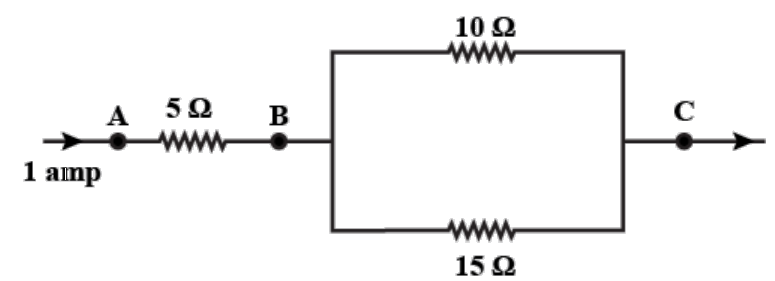
Three resistors are connected as shown in the diagram.
Through the resistor 5 ohm, a current of 1 ampere is flowing.
(i) What is the current through the other two resistors?
(ii) What is the potential difference across AB and AC?
(iii) What is the total resistance?


Answer
510.1k+ views
Hint – In order to solve this problem we need to find the potential difference between B and C then we can get the current. Then we have to apply the rules for connection series and parallel to get the equivalent resistance.
Formula used – V=IR, Total resistance in series = sum of all the resistances in series.
Complete Step-by-Step solution:
The current from A to B and B to C is 1 amp.
The resistors of 10 and 15 ohms are in parallel then the potential difference will be the same in both resistors.
The resistance between B and C will be $\dfrac{{10{\text{x15}}}}{{10\, + \,15}} = \dfrac{{150}}{{25}} = 6\Omega $.
Then the voltage between the resistor of 6 ohm and current of 1 amp is V=IR.
V=1(6)=6V
Therefore the potential difference is 6 volts in 10 and 15 ohm resistors.
(i)Then the current between 10 and 15 ohm resistor is,
${I_{10}} = \dfrac{{{V_{10}}}}{{10}} = \dfrac{6}{{10}} = 0.6A$
And ${I_{15}} = \dfrac{{{V_{15}}}}{{15}} = \dfrac{6}{{15}} = 0.4A$
(ii) Potential difference between AB is
${V_{AB}} = {I_{AB}}{R_{AB}} = 1{\text{ x 5 = 5V}}$
${V_{BC}} = {I_{BC}}{R_{BC}} = 1{\text{ x 6 = 6V}}$
So, ${V_{AC}} = {V_{AB}} + {V_{BC}} = 5 + 6 = 11$
Hence, the potential difference is 11 volts between AC and 5 volts between AB.
(iii) The equivalent resistance between A and C can be calculated as:
As the resistance between B and C is 6 ohm as calculated above.
And the resistance between A and B is 5 ohm we can clearly see they both are in series since the current passing through then is 1 ampere.
So, when the resistance is in series they add up to give the total effective resistance. So, ${R_{AC}} = 6 + 5 = 11\Omega $.
Note – To solve these types of problems we need to know the ohms law that is potential difference is directly proportional to resistance V=IR and we also need to know that in series the resistance adds up to give the effective resistance that it is larger than the largest resistance. Also the voltage in parallel resistances or any other elements connected in parallel are the same. Knowing this will solve your problem.
Formula used – V=IR, Total resistance in series = sum of all the resistances in series.
Complete Step-by-Step solution:
The current from A to B and B to C is 1 amp.
The resistors of 10 and 15 ohms are in parallel then the potential difference will be the same in both resistors.
The resistance between B and C will be $\dfrac{{10{\text{x15}}}}{{10\, + \,15}} = \dfrac{{150}}{{25}} = 6\Omega $.
Then the voltage between the resistor of 6 ohm and current of 1 amp is V=IR.
V=1(6)=6V
Therefore the potential difference is 6 volts in 10 and 15 ohm resistors.
(i)Then the current between 10 and 15 ohm resistor is,
${I_{10}} = \dfrac{{{V_{10}}}}{{10}} = \dfrac{6}{{10}} = 0.6A$
And ${I_{15}} = \dfrac{{{V_{15}}}}{{15}} = \dfrac{6}{{15}} = 0.4A$
(ii) Potential difference between AB is
${V_{AB}} = {I_{AB}}{R_{AB}} = 1{\text{ x 5 = 5V}}$
${V_{BC}} = {I_{BC}}{R_{BC}} = 1{\text{ x 6 = 6V}}$
So, ${V_{AC}} = {V_{AB}} + {V_{BC}} = 5 + 6 = 11$
Hence, the potential difference is 11 volts between AC and 5 volts between AB.
(iii) The equivalent resistance between A and C can be calculated as:
As the resistance between B and C is 6 ohm as calculated above.
And the resistance between A and B is 5 ohm we can clearly see they both are in series since the current passing through then is 1 ampere.
So, when the resistance is in series they add up to give the total effective resistance. So, ${R_{AC}} = 6 + 5 = 11\Omega $.
Note – To solve these types of problems we need to know the ohms law that is potential difference is directly proportional to resistance V=IR and we also need to know that in series the resistance adds up to give the effective resistance that it is larger than the largest resistance. Also the voltage in parallel resistances or any other elements connected in parallel are the same. Knowing this will solve your problem.
Recently Updated Pages
Master Class 10 General Knowledge: Engaging Questions & Answers for Success

Master Class 10 Science: Engaging Questions & Answers for Success

Master Class 10 Social Science: Engaging Questions & Answers for Success

Master Class 10 Maths: Engaging Questions & Answers for Success

Master Class 10 English: Engaging Questions & Answers for Success

Master Class 10 Computer Science: Engaging Questions & Answers for Success

Trending doubts
Why is there a time difference of about 5 hours between class 10 social science CBSE

Write a letter to the principal requesting him to grant class 10 english CBSE

What is the median of the first 10 natural numbers class 10 maths CBSE

The Equation xxx + 2 is Satisfied when x is Equal to Class 10 Maths

Which of the following does not have a fundamental class 10 physics CBSE

State and prove converse of BPT Basic Proportionality class 10 maths CBSE




